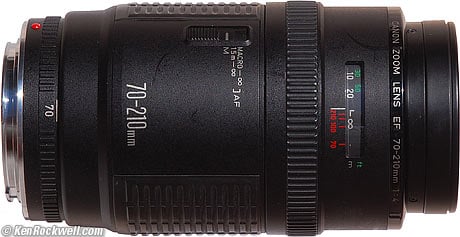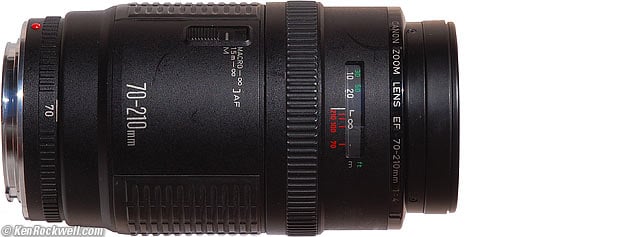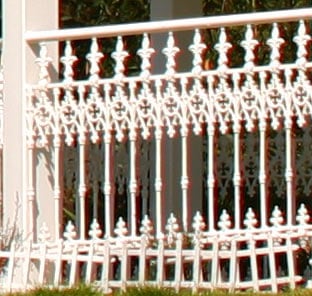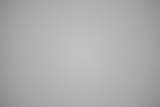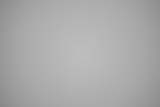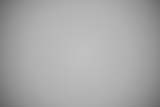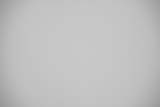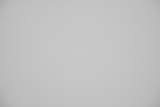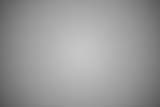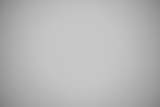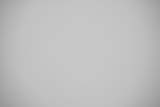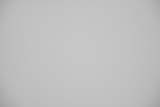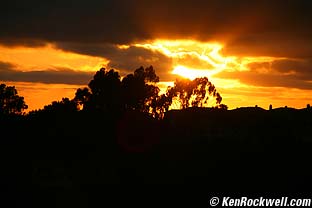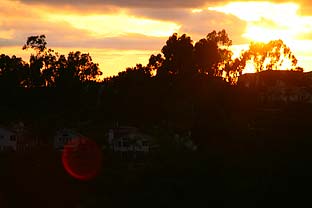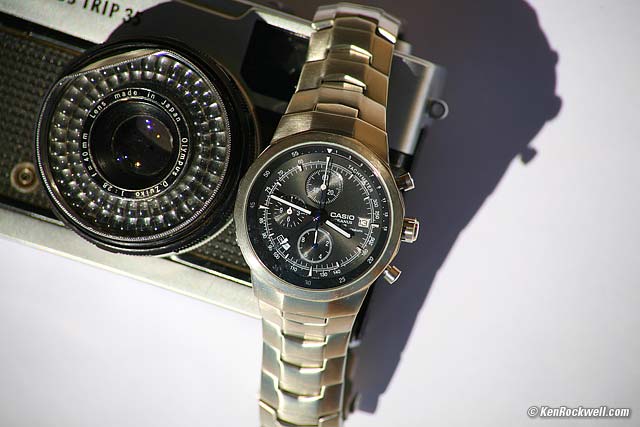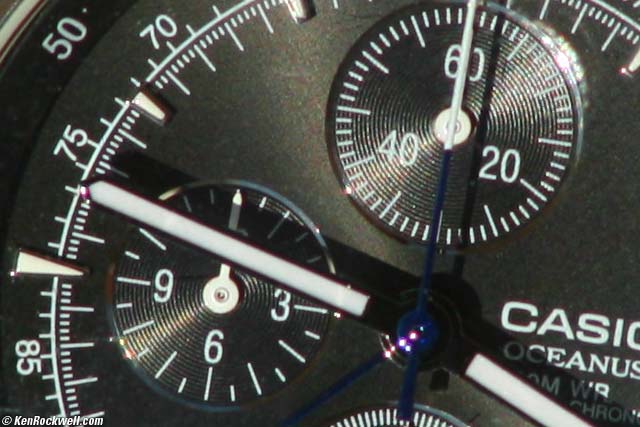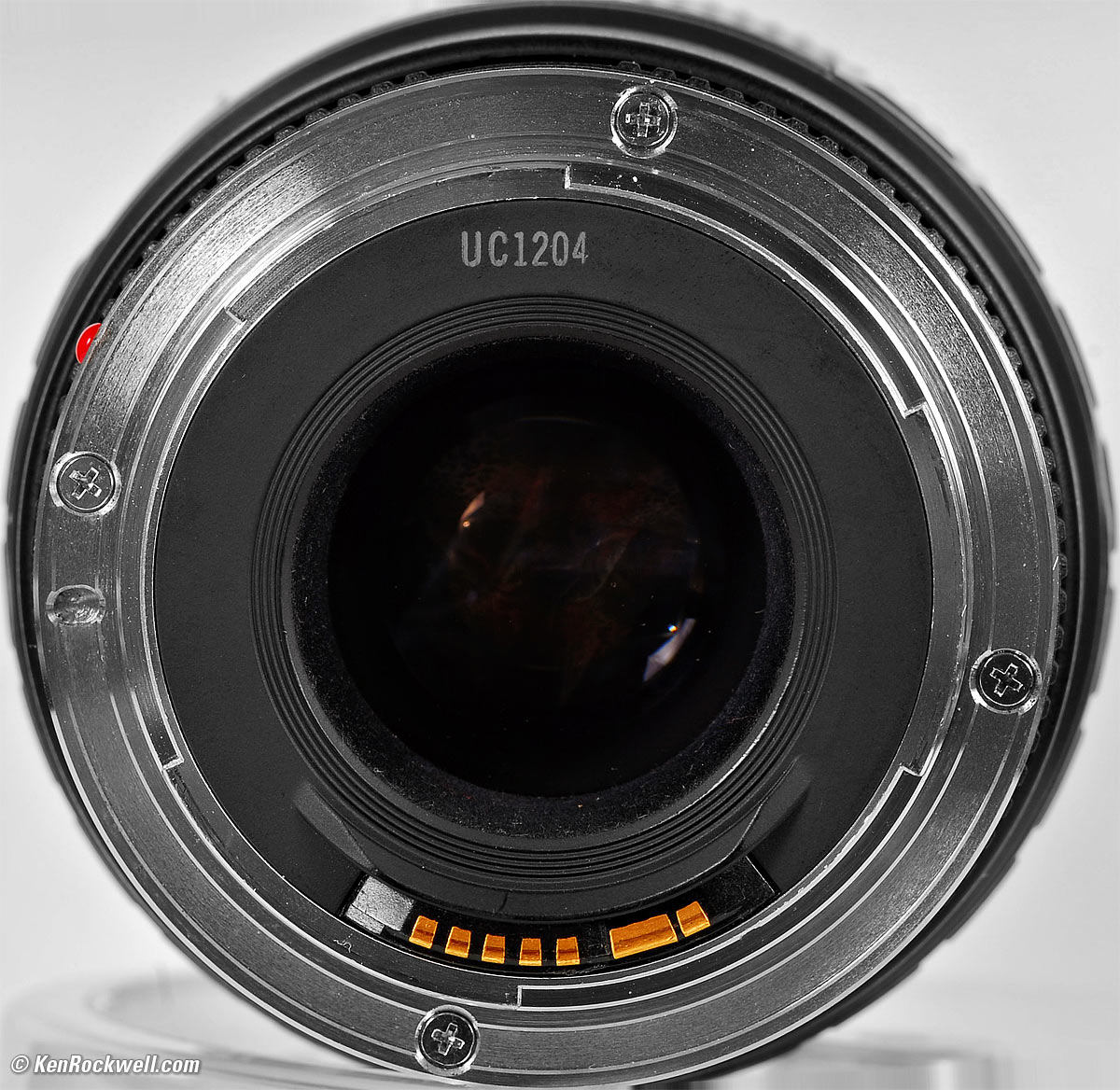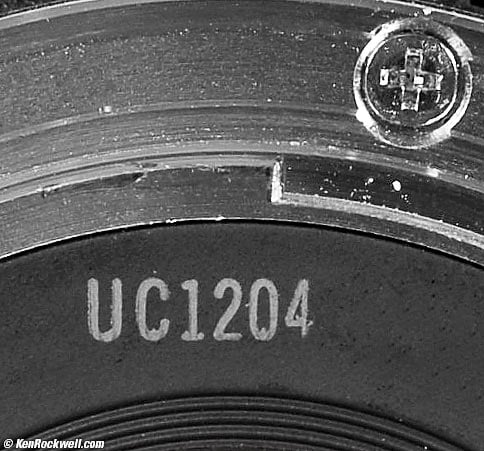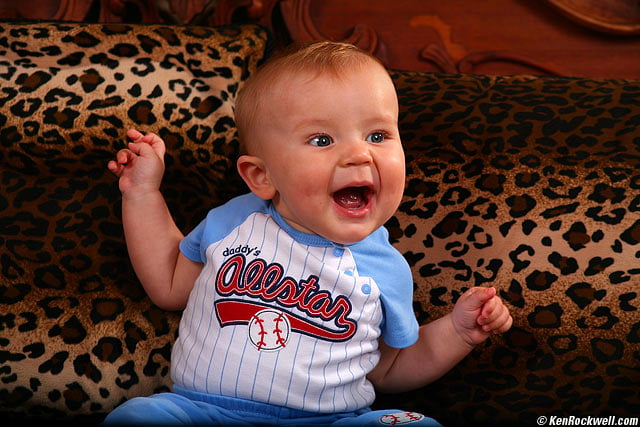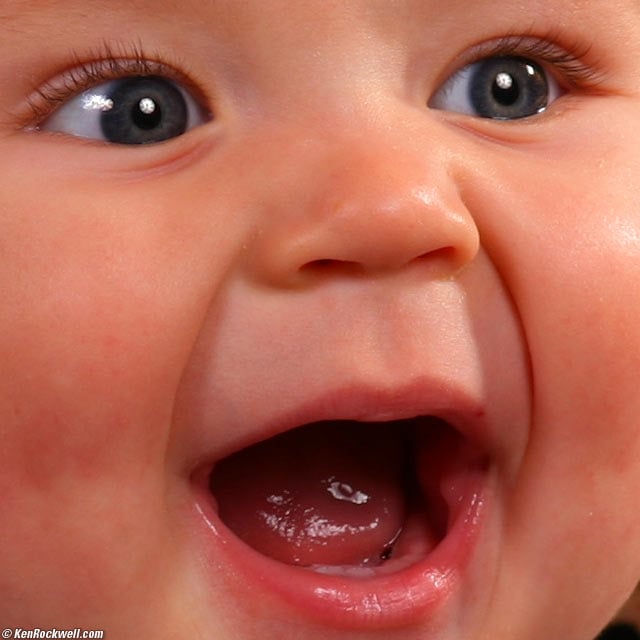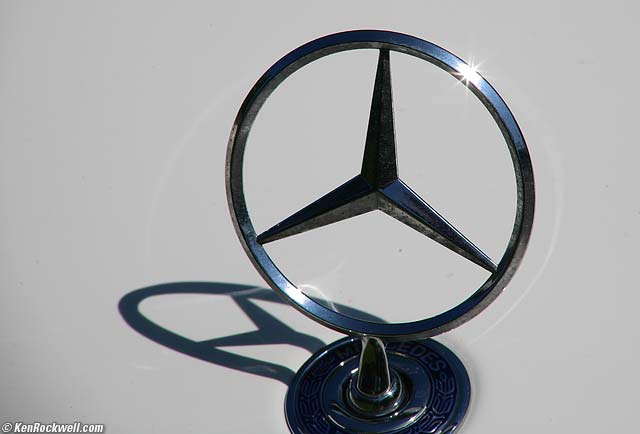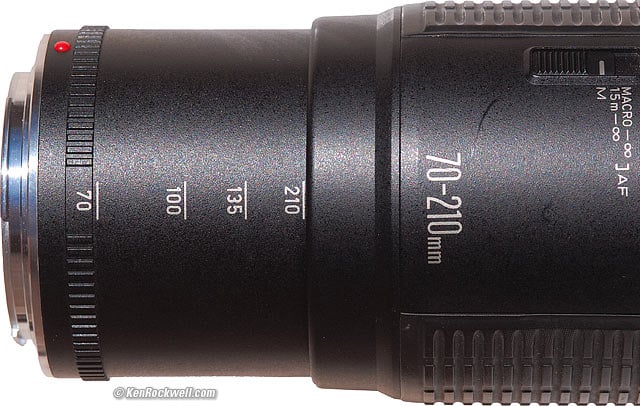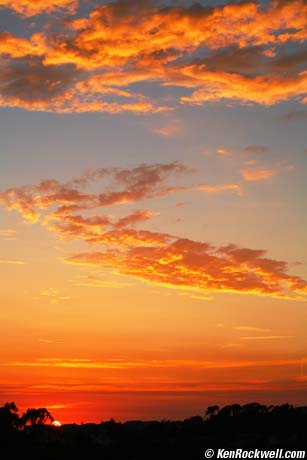Home Donate New Search Gallery Reviews How-To Books Links Workshops About Contact
Canon 70-210mm f/4
© 2014, 2007
KenRockwell.com
Canon EF 70-210mm f/4 (covers all formats, 58mm filters, 20.4 oz./578g, 3.9'/1.2m close focus, about $75 used). enlarge. I'd get it at this link directly to them at eBay (see How to Win at eBay).
June 2014 Canon Reviews Canon Lenses All Reviews
Top Specs Performance Recommendations
|
Adorama pays top dollar for your used gear. I use these stores. I can't vouch for ads below. |
This is Canon's first autofocus tele zoom, introduced May 1987. Mine is from December 1988. This EF 70-210mm f/4 was replaced by the also discontinued 70-210mm f/3.5-4.5 USM in June 1990.
Lenses exported from Japan of this vintage have gold JCII inspection stickers to the right of the focus window. These stickers usually have fallen off, but if you see one it's a sign of a well cared for lens.
Today they sell for about $150 used.
I found this Canon EF 70-210mm f/4 in the local classifieds for $100, so I picked it up for fun. At almost 20 years old it still works great.
Good News:
1.) Good Optics: Very sharp and few, if any, color fringes.
2.) Easy to zoom, slides in and out as if it's on ball bearings.
3.) Close focusing: 3.9 feet / 1.2m.
4.) Lightweight.
5.) Solid build quality.
6.) Constant f/4, a stop faster than any current inexpensive tele zoom at the long end.
Bad News:
1.) No Image Stabilization, critical for hand-held use.
2.) Manual focus requires a moving switch.
3.) Easy zooming means it's prone to the zoom sliding when pointed straight down.
SPECIFICATIONS with commentary
Top Introduction Performance Recommendations
Name: Canon calls this the Canon Zoom Lens EF 70-210mm f/4. EF means Electronic Focus, or that the focus motor is inside the lens. All modern Canon lenses focus with a motor in the lens.
Focal Length: 70-210mm. Used on a 1.3x camera it gives angles of view similar to what a 88-264mm lens would give on a 35mm film camera. On a 1.6x camera it gives angles of view similar to what a 114-340mm lens would give on a 35mm film camera. See also Crop Factor.
Maximum Aperture: f/4, constant.
Optics: 11 elements, 8 groups, one of which has been rumored to be a molded aspherical. This is a traditional push-pull zoom with front group focusing.
Diaphragm: 8 blades. Rounded up to f/8, octagonal from f/11 on. Stops down to f/32.
Filter Size: 58mm.
Close Focus: 3.9' (47" or 3' 11" or 1.2m) from the image plane (the back of the camera), measured.
Maximum Reproduction Ratio: 1:0.24
Infrared Focus Index? Yes, at 210, 135, 100 and 70mm.
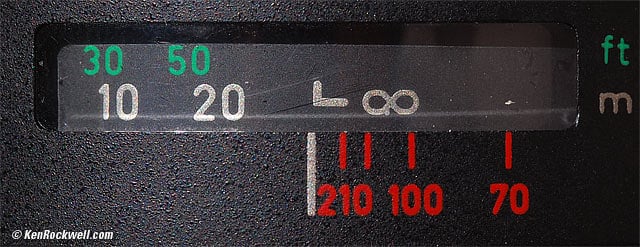
Canon 70-210mm f/4 IR focus indices
Size (measured): 2.975" diameter x 5.423" extension from flange (75.57 x 137.75mm) at 70mm focused at infinity. The Canon 70-210mm f/4 gets longer as zoomed and focused.
It grows an additional 1.438" (36.5mm) at 210mm, for a total extension from flange of 6.860" (174.25mm) at infinity.
The front group extends as focused more closely. Focus operates independently of zoom. At the close focus stop, the front of the lens extends an additional 0.771" (19.59mm).
Therefore, at 210mm at the closest focus distance the Canon 70-210mm f/4 EF extends a total of 7.631" (193.84mm) from the flange.
Canon 70-210mm f/4 at 70mm and infinity. Roll mouse over to zoom to 210mm and focus at 3.9.'
Weight: 20.400oz. (578.0 g), measured, naked. I measured the Canon 70-300mm IS at 22.2 oz (630g) is 5.63" long for comparison.
Introduced: May 1987.
Top Introduction Specs Recommendations
Autofocus Bokeh Color Color Fringes Construction Distortion
Ergonomics Eyeblow Falloff Film Filters Flare Macro
Program Mode Serial Number Sharpness Sunstars IS Zooming
The Canon EF 70-210mm f/4 is sharp and works great. The optics are as good as similar current lenses in actual use, although it's soft at f/4 and 210mm. The reason to pay more for the newest lenses are features like Image Stabilization, not optical quality.
FOCUSING back to Performance or back to Introduction.
Autofocus is excellent for the 1980s. It's why sports pros dropped Nikon and fled to Canon in the early 1990s. It has a reasonably fast internal motor to focus the lens, but it's noisier than newer lenses and you must move a switch for manual focus. Its very similar to the Canon 70-300mm IS.
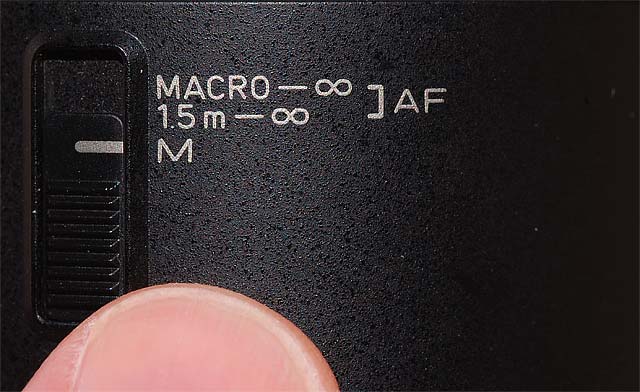
Canon 70-210mm f/4 focus switch.
What Moves
The front barrel and filter ring rotate with focus.
Focus Distance Scale
Yes, meters and feet.
Depth of Field Scale
NONE.
Speed
AF speed is quite reasonable, although the motor sounds like a toy car.
Sound and Noise
Autofocus: The motor sounds like a toy car.
Manual Focus: Sounds like gears sliding around.
Ease of Manual Focusing
It's OK, but you must slide a switch as you do on the the Canon 70-300mm IS. If you want to move between auto and manual focus simply by grabbing the focus ring, you need at least the Canon 70-200mm f/4L.
Autofocus Accuracy
I get perfect focus easily every time on my 5D.
On my Canon Rebel XTi I got varying results at f/4. It was fine at the wide end, but focused in front of the desired subject at the long end.
Autofocus accuracy varies from sample-to sample of camera and lens. Yours will be different than what I saw.
Focus Breathing
Breathing is a motion picture term which refers to what happens as you pull (change) focus from near to far. I list this for people putting these lenses on their Canon XL-1s for shooting video. Its irrelevant for still photography.
The image gets slightly larger as one focuses more closely.
BOKEH back to Performance or back to Introduction.
Bokeh is typical, varying of course with focal length and focus distance.
It's mediocre at f/4 at 70mm and 100mm (rolled-condom look to out-of-focus highlights behind the subject), near neutral at 135mm and neutral at 210mm. The lens' other aberrations play into the bokeh at 210mm, so the result is a rather undisturbing organic look instead of modern lens' harder look.
Here are examples of full images from a 1.6x format camera. The subject was focused at 10 feet (3m).
70mm f/4 |
100mm f/4 |
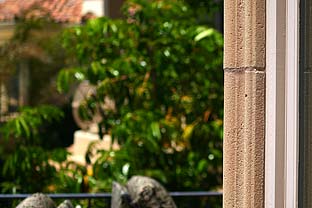 |
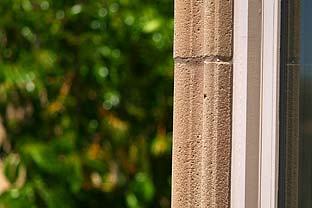 |
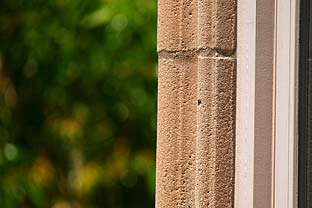 |
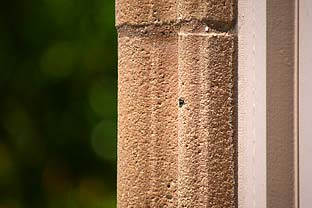 |
135mm f/4 |
210mm f/4 |
COLOR FRINGES
(Lateral Chromatic Aberration or LCA)
back to Performance or back to Introduction.
This lens is approved by the PPLFPA, Professional Patio and Lawn Furniture Photographers' Association, with a grade of "A-."
On a full-frame 5D, it has some minor color fringes at the shortest and longest ends in the corners, but none mid-range and none in the center.
Here are the full guide images from which the crops are taken:
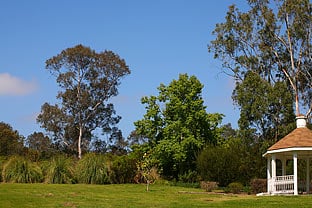 |
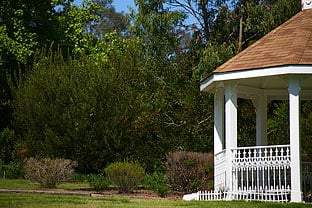 |
Full Image, 70mm |
Full Image, 210mm |
|
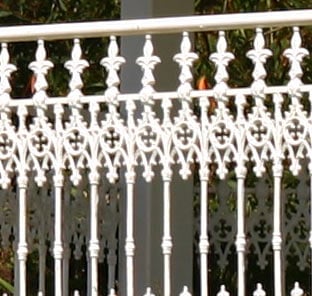 |
100% crop from 5D at 70mm |
100% crop from 5D at 100mm |
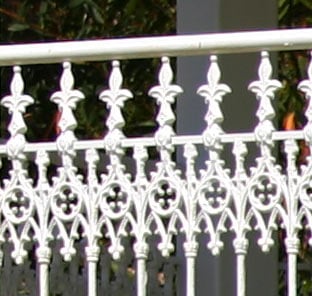 |
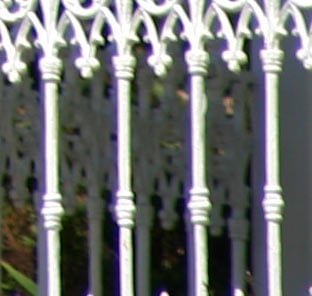 |
100% crop from 5D at 135mm |
100% crop from 5D at 210mm |
I see slight primary lateral chromatic aberration at 70mm (the red fringe going outside the main image) and slight secondary (green-magenta) at 210mm.
This is negligible. I had to create this torture test to see anything. I never saw it in real photography unless I deliberately shot trees against overcast skies at the ends of the zoom range. Photos of my white car were always perfect.
If you printed the full image the same magnification as these crops, you'd have 44" (110cm) wide prints!
The changes in color balance are from auto WB seeing more or less of the sky as I zoomed.
COLOR RENDITION back to Performance or back to Introduction.
I see no differences from my other Canon lenses.
back to Performance or back to Introduction.
Exterior: Plastic.
Filter Threads: Plastic.
Focus Ring: Ribbed soft plastic, which gives swell traction for the forces involved. One strong finger or two weak ones are fine for manual focusing.
Markings: Paint.
Switches: Plastic.
Mount: Metal.
Internals: Mostly metal.
Noises when shaken: Rattling and klunking, which is normal for an AF zoom lens.
Made in: Japan.
DISTORTION back to Performance or back to Introduction.
Distortion is exactly as I expected: barrel at 70mm, perfect at 100mm, and pincushion at 210mm.
Here's the proverbial Bad Photographers' Wall of Shame on a full-frame (or film) camera:
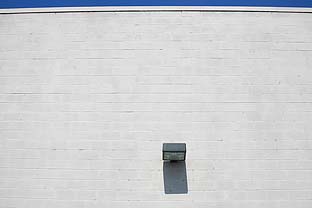 |
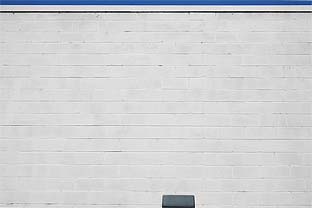 |
At 70mm, full-frame 5D |
At 100mm, full-frame 5D |
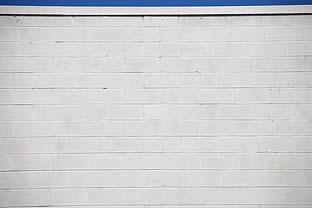 |
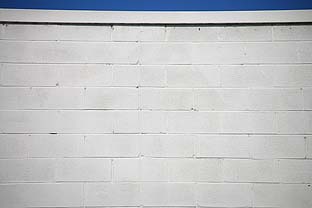 |
At 135mm, full-frame 5D |
At 210mm, full-frame 5D |
Plug these figures into Photoshop CS2's lens distortion filter to correct the distortion. These figures are for you to enjoy in your photography. These took me hours to calculate and are all © and registered, so you'll need permission to use these figures for anything else. Thanks! Ken.
20' (6m) |
50' (15m) |
Infinity |
|
70mm |
+3.1 |
+3.1 |
+3.5 |
100mm |
none |
none |
none |
135mm |
-2.7 |
-2.1 |
-1.4 |
210mm |
-3.2 |
-3.1 |
-3 |
These figures and examples are on full-frame. Performance will be better on 1.3x and 1.6x cameras.
ERGONOMICS back to Performance or back to Introduction.
Poorer ergonomics compared to the newest L series lenses are why you can buy this lens for a fifth to a tenth of what you'd pay for a new 70-200mm L.
This is an easy to use lens, but the lack of image stabilization, a push-pull zoom instead of a ring and the need to move a switch to get manual focus tend to get in my way.
EXPOSURE ACCURACY back to Performance or back to Introduction.
Exposure was fine, although it was a little underexposed at f/4 at 210mm. Even that is easy to compensate with the camera's exposure compensation control, or stop down a stop.
back to Performance or back to Introduction.
None. Zooming in and out didn't blow air out my viewfinder.
back to Performance or back to Introduction.
Falloff performance is normal and as expected.
Falloff is obvious on a full-frame camera at f/4 at 210mm. Otherwise it was invisible zoomed out, stopped down, or shot on a 1.3x and 1.6x camera. (see crop factor for why falloff is less of a problem on smaller format cameras.)
Here are shots of an Expodisc, which greatly exaggerates falloff and exposure issues.
